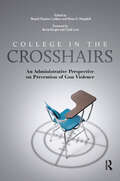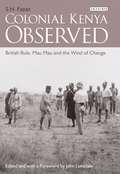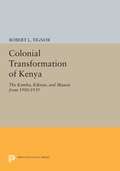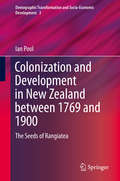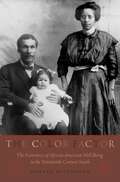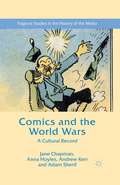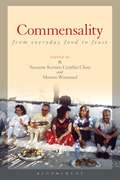- Table View
- List View
The Collapse of Parenting: How We Hurt Our Kids When We Treat Them Like Grown-Ups
by Leonard SaxIn this New York Times bestseller, one of America's premier child psychologists offers a must-read account of the dismal state of parenting today, and a vision for how we can better prepare our children for the challenges of the adult worldIn The Collapse of Parenting, internationally acclaimed author Leonard Sax argues that rising levels of obesity, depression, and anxiety among young people can be traced to parents abdicating their authority. The result is children who have no standard of right and wrong, who lack discipline, and who look to their peers and the Internet for direction. Sax shows how parents must reassert their authority - by limiting time with screens, by encouraging better habits at the dinner table, and by teaching humility and perspective - to renew their relationships with their children. Drawing on nearly thirty years of experience as a family physician and psychologist, along with hundreds of interviews with children, parents, and teachers, Sax offers a blueprint parents can use to help their children thrive in an increasingly complicated world.
Collective Political Rationality: Partisan Thinking and Why It's Not All Bad
by Gregory E. McAvoyAmidst the polarization of contemporary politics, partisan loyalties among citizens are regarded as one contributor to political stalemate. Partisan loyalties lead Democrats and Republicans to look at the same economic information but to come to strikingly different conclusions about the state of the economy and the performance of the president in managing it. As a result, many observers argue that democratic politics would work better if citizens would shed their party loyalty and more dispassionately assess political and economic news. In this book, Gregory E. McAvoy argues—contra this conventional wisdom; that partisanship is a necessary feature of modern politics, making it feasible for citizens to make some sense of the vast number of issues that make their way onto the political agenda. Using unique data, he shows that the biases and distortions that partisanship introduces to collective opinion are real, but despite them, collective opinion changes meaningfully in response to economic and political news. In a comparison of the public’s assessment of the economy to those of economic experts, he finds a close correspondence between the two over time, and that in modern democracies an informed public will also necessarily be partisan. Modernizing the study of collective opinion, McAvoy's book is essential reading for scholars of American Public Opinion and Political Behavior.
Collective Political Rationality: Partisan Thinking and Why It's Not All Bad
by Gregory E. McAvoyAmidst the polarization of contemporary politics, partisan loyalties among citizens are regarded as one contributor to political stalemate. Partisan loyalties lead Democrats and Republicans to look at the same economic information but to come to strikingly different conclusions about the state of the economy and the performance of the president in managing it. As a result, many observers argue that democratic politics would work better if citizens would shed their party loyalty and more dispassionately assess political and economic news. In this book, Gregory E. McAvoy argues—contra this conventional wisdom; that partisanship is a necessary feature of modern politics, making it feasible for citizens to make some sense of the vast number of issues that make their way onto the political agenda. Using unique data, he shows that the biases and distortions that partisanship introduces to collective opinion are real, but despite them, collective opinion changes meaningfully in response to economic and political news. In a comparison of the public’s assessment of the economy to those of economic experts, he finds a close correspondence between the two over time, and that in modern democracies an informed public will also necessarily be partisan. Modernizing the study of collective opinion, McAvoy's book is essential reading for scholars of American Public Opinion and Political Behavior.
College for Students with Disabilities: We Do Belong
by Dena Gassner Mitchell Nagler Francine Conway Anita Frey Alyssa L. Conigliaro Chanelle Tyler Best Karleen Haines Sonia Minutella Melissa Mooney Patrick Kelty Diana Damilatis Kerry Magro Ehrin McHenry Kelsey McLaughlinThis book presents a realistic picture of the positive and negative aspects of the transition to higher education as experienced by students with disabilities. It combines findings from special education studies, personal stories from individuals with disabilities, and tips for both individuals and professionals facing the challenges.
College in the Crosshairs: An Administrative Perspective on Prevention of Gun Violence
Gun violence – whether rampage shootings, homicides or suicides – is a potential reality all campuses have to face. This book provides leaders in higher education – and particularly those in student affairs – with data about past incidents, an analysis of trends, and background on the national debate about gun policies and how they impact colleges, state by state. It importantly raises issues about student psychological development, mental health, and the prevalence of alcohol and substance abuse on campus, to better inform discussion about allowing guns on campus and concealed carry. It concludes by sharing strategies for averting gun-related tragedies, and offering models for responding when they occur, based on lessons learned and best practices. The book addresses concealed carry legislation and its impact on campus policies by state, examining the concerns of administrators as they discharge their duty of care to students and comply with legal and regulatory frameworks. Asking “Are our students developmentally ready to make a morally sophisticated, life-changing decision to use firearms in response to a real or perceived threat?”, it offers important perspectives and scientific data, so far absent from the debate, to shape the ongoing conversation with lawmakers and the public about what it takes to keep college communities safe.In addressing risk and prevention, contributors cover the relationship between violence and mental health, and the need to establish comprehensive strategic plans and a preventative framework that promotes help-seeking for those in need before they reach the point of crisis, as well as a campus-wide risk assessment team, stressing the importance of cultivating a community-wide approach to campus safety by empowering members to report suspicious behavior. They also offer guidance on improving effective behavior intervention and case management processes.The book concludes by outlining best practices, and providing guidance on developing an emergency plan, practicing and testing systems, and creating a robust communications strategy. Individual chapters focus on how small colleges with limited resources can develop effective plans into by partnering with local agencies; as well as on the steps that community colleges – who generally lack resident advisors and residential staff, and whose students are far more dispersed – can take to diminish risk and respond promptly and professionally to a crisis.This is an essential guide for all higher education leaders concerned about preventing violence on our campuses, and a call to action.
College in the Crosshairs: An Administrative Perspective on Prevention of Gun Violence
by Brandi Hephner LaBanc Brian O. HemphillGun violence – whether rampage shootings, homicides or suicides – is a potential reality all campuses have to face. This book provides leaders in higher education – and particularly those in student affairs – with data about past incidents, an analysis of trends, and background on the national debate about gun policies and how they impact colleges, state by state. It importantly raises issues about student psychological development, mental health, and the prevalence of alcohol and substance abuse on campus, to better inform discussion about allowing guns on campus and concealed carry. It concludes by sharing strategies for averting gun-related tragedies, and offering models for responding when they occur, based on lessons learned and best practices. The book addresses concealed carry legislation and its impact on campus policies by state, examining the concerns of administrators as they discharge their duty of care to students and comply with legal and regulatory frameworks. Asking “Are our students developmentally ready to make a morally sophisticated, life-changing decision to use firearms in response to a real or perceived threat?”, it offers important perspectives and scientific data, so far absent from the debate, to shape the ongoing conversation with lawmakers and the public about what it takes to keep college communities safe.In addressing risk and prevention, contributors cover the relationship between violence and mental health, and the need to establish comprehensive strategic plans and a preventative framework that promotes help-seeking for those in need before they reach the point of crisis, as well as a campus-wide risk assessment team, stressing the importance of cultivating a community-wide approach to campus safety by empowering members to report suspicious behavior. They also offer guidance on improving effective behavior intervention and case management processes.The book concludes by outlining best practices, and providing guidance on developing an emergency plan, practicing and testing systems, and creating a robust communications strategy. Individual chapters focus on how small colleges with limited resources can develop effective plans into by partnering with local agencies; as well as on the steps that community colleges – who generally lack resident advisors and residential staff, and whose students are far more dispersed – can take to diminish risk and respond promptly and professionally to a crisis.This is an essential guide for all higher education leaders concerned about preventing violence on our campuses, and a call to action.
Colonial Kenya Observed: British Rule, Mau Mau and the Wind of Change
by S. H. FazanThe coast of East Africa was considered a strategically invaluable region for the establishment of trading ports, both for Arab and Persian merchants, long prior to invasion and conquest by Europeans. In the initial stages of the scramble for Africa in the 18th century, control of the area was an aspiration for every colonial nation in Europe – but it was not until 1895 that it was finally dominated by a sole power and proclaimed The Protectorate of British East Africa. In the early 20th century, the coast was brimming with vitality as immigrants, colonisers and missionaries from Arabia, India and Europe poured in to take advantage of growing commercial opportunities – including the prospect of enslaving millions of native Africans. The development of Kenya is an exceptional tale within the history of British rule – in perhaps no other colony did nationalistic feeling evolve in conditions of such extensive social and political change. In 1911, S.H. Fazan sailed to what later became the Republic of Kenya to work for the colonial government. Immersing himself in knowledge of traditional language and law, he recorded the vast changes to local culture that he encountered after decades of working with both the British administration and the Kenyan people. This work charts the sweeping tide of social change that occurred through his career with the clarity and insight that comes with a total intimacy of a country. His memoirs examine the fascinating complexity of interaction between the colonial and native courts, commercial land reform and the revolutionised dynamic of labour relations. By further unearthing the political tensions that climaxed with the Mau Mau Revolt of 1952-1960, this invaluable work on the European colonial period paints a comprehensive and revealing firsthand account for anyone with an interest in British and African history. Fazan's story provides a quite unparalleled view of colonial Africa and the conduct of Empire across half a century.
Colonial Switzerland: Rethinking Colonialism from the Margins (Cambridge Imperial and Post-Colonial Studies Series)
by Harald Fischer-Tiné Patricia PurtschertStates without former colonies, it has been argued, were intensely involved in colonial practices. This anthology looks at Switzerland, which, by its very strong economic involvements with colonialism, its doctrine of neutrality, and its transnationally entangled scientific community, constitutes a perfect case in point.
Colonial Transformation of Kenya: The Kamba, Kikuyu, and Maasai from 1900-1939 (PDF)
by Robert L. TignorThis book takes an entirely new approach to the evolution of cities and of societies in premodern periods. Refining the theory advanced in his earlier study of China and Japan, Gilbert Rozman examines the development of Russia over several centuries with emphasis on the period immediately preceding the Industrial Revolution. He makes possible comparison of urbanization in five countries (including England and France as well as Russia) and develops a systematic framework for analyzing cities of varying size. Treatment of Russia includes a history of urban development prior to 1750, an examination of late eighteenth-century social structure as it related to cities, and a study of regional variations in urbanization. The author presents a wealth of information until now unavailable in English. Since this information is provided in a format similar to that used in the earlier book, data on Russia can readily be placed in broad perspective. Comparisons with the other countries show that Russia's development was less slow than has been supposed. Separate sections on England and France supply estimates of the number of settlements at each level of their urban hierarchies.Originally published in 1976.The Princeton Legacy Library uses the latest print-on-demand technology to again make available previously out-of-print books from the distinguished backlist of Princeton University Press. These editions preserve the original texts of these important books while presenting them in durable paperback and hardcover editions. The goal of the Princeton Legacy Library is to vastly increase access to the rich scholarly heritage found in the thousands of books published by Princeton University Press since its founding in 1905.
Colonization and Development in New Zealand between 1769 and 1900: The Seeds of Rangiatea (Demographic Transformation and Socio-Economic Development #3)
by Ian PoolThis book details the interactions between the Seeds of Rangiatea, New Zealand’s Maori people of Polynesian origin, and Europe from 1769 to 1900. It provides a case-study of the way Imperial era contact and colonization negatively affected naturally evolving demographic/epidemiologic transitions and imposed economic conditions that thwarted development by precursor peoples, wherever European expansion occurred. In doing so, it questions the applicability of conventional models for analyses of colonial histories of population/health and of development.The book focuses on, and synthesizes, the most critical parts of the story, the health and population trends, and the economic and social development of Maori. It adopts demographic methodologies, most typically used in developing countries, which allow the mapping of broad changes in Maori society, particularly their survival as a people.The book raises general theoretical questions about how populations react to the introduction of diseases to which they have no natural immunity. Another more general theoretical issue is what happens when one society’s development processes are superseded by those of some more powerful force, whether an imperial power or a modern-day agency, which has ingrained ideas about objectives and strategies for development. Finally, it explores how health and development interact.The Maori experience of contact and colonization, lasting from 1769 to circa 1900, narrated here, is an all too familiar story for many other territories and populations, Natives and former colonists. This book provides a case-study with wider ramifications for theory in colonial history, development studies, demography, anthropology and other fields.
COLOR FACTOR C: The Economics of African-American Well-Being in the Nineteenth-Century South
by Howard BodenhornDespite the many advances that the United States has made in racial equality over the past half century, numerous events within the past several years have proven prejudice to be alive and well in modern-day America. In one such example, Governor Nikki Haley of South Carolina dismissed one of her principal advisors in 2013 when his membership in the ultra-conservative Council of Conservative Citizens (CCC) came to light. According to the Southern Poverty Law Center, in 2001 the CCC website included a message that read "God is the one who divided mankind into different races.... Mixing the races is rebelliousness against God." This episode reveals America's continuing struggle with race, racial integration, and race mixing-a problem that has plagued the United States since its earliest days as a nation. The Color Factor: The Economics of African-American Well-Being in the Nineteenth-Century South demonstrates that the emergent twenty-first-century recognition of race mixing and the relative advantages of light-skinned, mixed-race people represent a re-emergence of one salient feature of race in America that dates to its founding. Economist Howard Bodenhorn presents the first full-length study of the ways in which skin color intersected with policy, society, and economy in the nineteenth-century South. With empirical and statistical rigor, the investigation confirms that individuals of mixed race experienced advantages over African Americans in multiple dimensions - in occupations, family formation and family size, wealth, health, and access to freedom, among other criteria. The Color Factor concludes that we will not really understand race until we understand how American attitudes toward race were shaped by race mixing. The text is an ideal resource for students, social scientists, and historians, and anyone hoping to gain a deeper understanding of the historical roots of modern race dynamics in America.
Color Stories: Black Women and Colorism in the 21st Century (Intersections of Race, Ethnicity, and Culture)
by JeffriAnne WilderThis book offers an in-depth sociological exploration of present-day colorism in the lives of black women, investigating the lived experiences of a phenomenon that continues to affect women of African descent.Race still matters. And for black women, the related issues of skin tone are just as important today as in decades past. Part cultural commentary, part empirical analysis, this book offers a compelling study and discussion of colorism—a widely discussed but understudied issue in "post-racial" America—that demonstrates how powerful a factor skin color remains in the everyday lives of young black women. Author JeffriAnne Wilder conducted interviews with dozens of young black women about the role of colorism in their everyday lives. Collectively, these findings offer a compelling empirical and theoretical analysis of colorism in key areas of 21st-century life, including within family and school settings, in the media, and in intimate relationships.The culmination of nearly two decades of the author's deep entrenchment in colorism studies, Color Stories: Black Women and Colorism in the 21st Century provides a new perspective on a controversial issue that has been a part of black culture and academic study for generations by exploring how the contemporary nature of colorism—from Facebook to the First Lady to Beyoncé—impacts the ideas and experiences of black women. This work serves as essential reading for anyone interested in learning more about the historical and contemporary significance of colorism in modern-day America, regardless of the reader's race, sex, or age.
Color Stories: Black Women and Colorism in the 21st Century (Intersections of Race, Ethnicity, and Culture)
by JeffriAnne WilderThis book offers an in-depth sociological exploration of present-day colorism in the lives of black women, investigating the lived experiences of a phenomenon that continues to affect women of African descent.Race still matters. And for black women, the related issues of skin tone are just as important today as in decades past. Part cultural commentary, part empirical analysis, this book offers a compelling study and discussion of colorism—a widely discussed but understudied issue in "post-racial" America—that demonstrates how powerful a factor skin color remains in the everyday lives of young black women. Author JeffriAnne Wilder conducted interviews with dozens of young black women about the role of colorism in their everyday lives. Collectively, these findings offer a compelling empirical and theoretical analysis of colorism in key areas of 21st-century life, including within family and school settings, in the media, and in intimate relationships.The culmination of nearly two decades of the author's deep entrenchment in colorism studies, Color Stories: Black Women and Colorism in the 21st Century provides a new perspective on a controversial issue that has been a part of black culture and academic study for generations by exploring how the contemporary nature of colorism—from Facebook to the First Lady to Beyoncé—impacts the ideas and experiences of black women. This work serves as essential reading for anyone interested in learning more about the historical and contemporary significance of colorism in modern-day America, regardless of the reader's race, sex, or age.
Colorblindness, Post-raciality, and Whiteness in the United States
by Sherrow O. PinderThis book problematizes the ways in which the discourses of colorblindness and post-raciality are articulated in the age of Obama. Pinder debunks the myth that race does not matter and reconsiders the presumptive hegemony of whiteness through the dialectics of visibility and invisibility of race.
Colored Television: American Religion Gone Global (RaceReligion)
by Marla FrederickThe presence of women and African Americans not simply as viewers, but also as televangelists and station owners in their own right has dramatically changed the face of American religious broadcasting in recent decades. Colored Television looks at the influence of these ministries beyond the United States, where complex gospels of prosperity and gospels of sexual redemption mutually inform one another while offering hopeful yet socially contested narratives of personal uplift. As an ethnography, Colored Television illuminates the phenomenal international success of American TV preachers like T.D. Jakes, Creflo Dollar, Joyce Meyer, and Juanita Bynum. Focusing particularly on Jamaica and the Caribbean, it also explores why the genre has resonated so powerfully around the world. Investigating the roles of producers, consumers, and distributors, Marla Frederick takes a unique look at the ministries, the communities they enter, and the global markets of competition that buffer them.
The Columbian Covenant: Race And The Writing Of American History
by James CarsonThis provocative analysis of American historiography argues that when scholars use modern racial language to articulate past histories of race and society, they collapse different historical signs of skin color into a transhistorical and essentialist notion of race that implicates their work in the very racial categories they seek to transcend.
Combat Social Work: Applying the Lessons of War to the Realities of Human Services
by Charles R. Figley, Jeffrey S. Yarvis and Bruce A. ThyerSocial workers have a long, proud history of service in most branches of the United States military. The experiences of social workers and other human service professionals of all military ranks have an important, often profound, and lasting impact that informs not only their practice within the military but throughout their career long after they have left the combat zone. In exploring the experiences of 13 American combat social workers (CSWs)--whose role is, among other things, providing military mental health services to members in their unit--this book shares lessons from military service through the lens of social work practitioners. The text includes strategies learned about social work practice in a war zone that are highly applicable to other highly stressful contexts (e.g., crisis intervention, stress reduction procedures, suicide prevention, brief psychotherapy, and consultation on family issues). Combat Social Work is uniquely positioned to serve as a valuable resource for social workers and other mental health providers interested in the assessment and treatment of trauma with active members of the military and military veterans.
Comedy and Social Science: Towards a Methodology of Funny (Routledge Advances in Sociology)
by Cate WatsonWhile there have been many sociological and psychological studies of humor, few can claim to be funny. Humor may be regarded as a legitimate topic for social scientists, but in general, they present their research rather seriously. In academia, humor tends to be trivialized and dismissed. This is more than just a missed opportunity for otherwise fun-loving academics. In literature, it is readily accepted that comedy is integral to the human condition. To ignore humor is to reject a potentially insightful methodological approach, as the humorous worldview presents unique opportunities for investigating the social. This book constitutes a unique resource, presenting chapters on irony, satire and parody as tools for analysis and means of representation, as well as considering humor in the conduct of research, and offering guidance on getting published. Through presenting examples from across the social sciences, the book seeks to persuade and inspire rather than to prescribe an approach – a closure which would (ironically) be inimical to the multiplicity and ambiguity which characterizes humorous research and lends it its distinctive edge.
Comedy and Social Science: Towards a Methodology of Funny (Routledge Advances in Sociology #153)
by Cate WatsonWhile there have been many sociological and psychological studies of humor, few can claim to be funny. Humor may be regarded as a legitimate topic for social scientists, but in general, they present their research rather seriously. In academia, humor tends to be trivialized and dismissed. This is more than just a missed opportunity for otherwise fun-loving academics. In literature, it is readily accepted that comedy is integral to the human condition. To ignore humor is to reject a potentially insightful methodological approach, as the humorous worldview presents unique opportunities for investigating the social. This book constitutes a unique resource, presenting chapters on irony, satire and parody as tools for analysis and means of representation, as well as considering humor in the conduct of research, and offering guidance on getting published. Through presenting examples from across the social sciences, the book seeks to persuade and inspire rather than to prescribe an approach – a closure which would (ironically) be inimical to the multiplicity and ambiguity which characterizes humorous research and lends it its distinctive edge.
Comics and the World Wars: A Cultural Record (Palgrave Studies in the History of the Media)
by Jane L. Chapman Andrew Kerr Adam Sherif Anna HoylesThis transnational, interdisciplinary study argues for the use of comics as a primary source. In recuperating currently unknown or neglected strips the authors demonstrate that these examples, produced during the World Wars, act as an important cultural record, providing, amongst other information, a barometer for contemporary popular thinking.
Comics, the Holocaust and Hiroshima (The Holocaust and its Contexts)
by Jane L. Chapman Dan Ellin Adam SherifComics, the Holocaust and Hiroshima breaks new ground for history by exploring the relationship between comics as a cultural record, historiography, memory and trauma studies. Comics have a dual role as sources: for gauging awareness of the Holocaust and through close analysis, as testimonies and narratives of childhood emotions and experiences.
Coming of Age in Second Life: An Anthropologist Explores the Virtually Human
by Tom BoellstorffMillions of people around the world today spend portions of their lives in online virtual worlds. Second Life is one of the largest of these virtual worlds. The residents of Second Life create communities, buy property and build homes, go to concerts, meet in bars, attend weddings and religious services, buy and sell virtual goods and services, find friendship, fall in love--the possibilities are endless, and all encountered through a computer screen. At the time of its initial publication in 2008, Coming of Age in Second Life was the first book of anthropology to examine this thriving alternate universe. Tom Boellstorff conducted more than two years of fieldwork in Second Life, living among and observing its residents in exactly the same way anthropologists traditionally have done to learn about cultures and social groups in the so-called real world. He conducted his research as the avatar "Tom Bukowski," and applied the rigorous methods of anthropology to study many facets of this new frontier of human life, including issues of gender, race, sex, money, conflict and antisocial behavior, the construction of place and time, and the interplay of self and group. Coming of Age in Second Life shows how virtual worlds can change ideas about identity and society. Bringing anthropology into territory never before studied, this book demonstrates that in some ways humans have always been virtual, and that virtual worlds in all their rich complexity build upon a human capacity for culture that is as old as humanity itself. Now with a new preface in which the author places his book in light of the most recent transformations in online culture, Coming of Age in Second Life remains the classic ethnography of virtual worlds.
Coming of Age in Second Life: An Anthropologist Explores the Virtually Human (PDF)
by Tom BoellstorffMillions of people around the world today spend portions of their lives in online virtual worlds. Second Life is one of the largest of these virtual worlds. The residents of Second Life create communities, buy property and build homes, go to concerts, meet in bars, attend weddings and religious services, buy and sell virtual goods and services, find friendship, fall in love--the possibilities are endless, and all encountered through a computer screen. At the time of its initial publication in 2008, Coming of Age in Second Life was the first book of anthropology to examine this thriving alternate universe. Tom Boellstorff conducted more than two years of fieldwork in Second Life, living among and observing its residents in exactly the same way anthropologists traditionally have done to learn about cultures and social groups in the so-called real world. He conducted his research as the avatar "Tom Bukowski," and applied the rigorous methods of anthropology to study many facets of this new frontier of human life, including issues of gender, race, sex, money, conflict and antisocial behavior, the construction of place and time, and the interplay of self and group. Coming of Age in Second Life shows how virtual worlds can change ideas about identity and society. Bringing anthropology into territory never before studied, this book demonstrates that in some ways humans have always been virtual, and that virtual worlds in all their rich complexity build upon a human capacity for culture that is as old as humanity itself. Now with a new preface in which the author places his book in light of the most recent transformations in online culture, Coming of Age in Second Life remains the classic ethnography of virtual worlds.
Commensality: From Everyday Food to Feast
by Susanne Kerner Cynthia Chou Morten WarmindThroughout time and in every culture, human beings have eaten together. Commensality - eating and drinking at the same table - is a fundamental social activity, which creates and cements relationships. It also sets boundaries, including or excluding people according to a set of criteria defined by the society. Particular scholarly attention has been paid to banquets and feasts, often hosted for religious, ritualistic or political purposes, but few studies have considered everyday commensality.Commensality: From Everyday Food to Feast offers an insight into this social practice in all its forms, from the most basic and mundane meals to the grandest occasions. Bringing together insights from anthropologists, archaeologists and historians, this volume offers a vast historical scope, ranging from the Late Neolithic period (6th millennium BC), through the Middle Ages, to the present day. The sixteen chapters include case studies from across the world, including the USA, Bolivia, China, Southeast Asia, Iran, Turkey, Portugal, Denmark and the UK. Connecting these diverse analyses is an understanding of commensality's role as a social and political tool, integral to the formation of personal and national identities.From first experiences of commensality in the sharing of food between a mother and child, to the inaugural dinner of the American president, this collection of essays celebrates the variety of human life and society.
The Common-Sense Guide to Improving the Safeguarding of Children: Three Steps to Make A Real Difference
by Terry McCarthyThis book presents a simple and direct three-step approach for developing effective safeguarding practice, providing structured guidance for frontline managers and practitioners.



